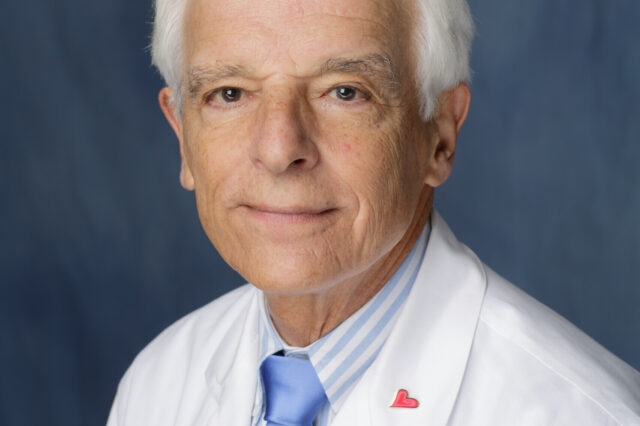UF Health cardiologist: COVID-19 might be a disease of the lungs and the heart

As researchers continue to unravel the mysteries of COVID-19, they are increasingly realizing the disease caused by the novel coronavirus often involves more than the lungs that it ravages. It can have a devastating impact on the the domain of the cardiologist: the heart.
University of Florida Health cardiologist Carl J. Pepine, M.D., a professor in and former chief of the UF College of Medicine’s division of cardiovascular medicine, said scientists are studying how the virus can infect heart muscle and blood vessels as well as the lungs. The virus, for instance, is known to enter the body through the ACE-2 receptors of the lungs, but such receptors are also found in the cardiovascular system.
Patients with prior cardiovascular disease are at high risk for getting the disease. When they do, Pepine said, they are most in danger of cardiovascular complications during a later stage of COVID-19, when small proteins called cytokines can trigger an outsized immune response called a “cytokine storm.” While cytokines can be beneficial in triggering an immune response to fight infection, in the case of COVID-19, the storm can contribute to multiorgan failure and even death.
Here, Pepine explains how COVID-19 presents challenges to cardiologists who need to unravel the effects of the disease from symptoms that might be seen in a patient suffering unrelated heart trouble.
Q: If COVID-19 is a lung disease, why has it become a concern for cardiologists?
A: COVID-19 was viewed as a typical respiratory, flu-like illness. But the more we got involved with it, the more we’ve come to realize that it has multiple cardiovascular implications. And these implications are very far-reaching, particularly for patients who move out of the early viral response phase of the disease. They start moving into the hyperinflammation, or cytokine phase, where there’s multiple system involvement and multiple manifestations of the disease in the cardiovascular system. As patients move into a phase where the cytokines increase, we’re seeing elevations in cardiac troponin, a type of protein released from heart muscle cells when they’re injured. It’s clearly not simply a respiratory illness.
Q: Why has cardiac troponin become so important when evaluating COVID-19 patients?
A: What’s coming out in the literature relative to COVID-19 is the level of this cardiac troponin molecule is probably one of best prognostic markers that we have for which COVID-19 patients will do poorly. Pretty much all severely ill COVID-19 patients will have elevated levels of troponin.
Q: Isn’t elevated troponin seen when someone is suffering a heart attack?
A: Yes. An elevation in cardiac troponin does mimic what we see in a garden-variety heart attack that results from a sudden blockage of a large coronary artery. It also is seen in COVID-19 and doesn’t necessarily represent a heart attack or a large coronary artery of the heart that is occluded by a blood clot. Once a physician sees the troponin level starting to rise, that’s the time for them to get a cardiology consult. At that point, it is also important to do additional cardiac testing. The one we would recommend, in addition to the ECG, is an echocardiogram, which has the ability in a noninvasive way to image the heart and determine if the heart muscle function is normal or abnormal.
Q: When someone presents with elevated troponin, typically they are immediately sent to the heart catherization lab so a balloon can be inserted to open an occluded coronary artery. Does COVID-19 change that thinking?
A: Yes, in the era of this pandemic, our thinking has changed. There’s been concern that if we measure cardiac troponin in every suspected case of COVID-19, it could lead to the overwhelming of our system as we get people into a cath lab to be sure they don’t have the garden-variety heart attack with a thrombosis in a large coronary artery. Most of us understand now there are many other mechanisms for a cardiac tropoinin increase in these patients and also other ways to evaluate them when we know or suspect they have COVID-19. For example, these patients can get profound changes on their electrocardiogram, which is another means to evaluate them. The echocardiogram is probably the next quickest way to contine this sort of evaluation.
Q: Some medical facilities are reporting fewer heart attack and stroke patients coming to emergency rooms. Why is that?
A: People are asking, where have all those heart attacks and strokes gone? And it’s even more curious if you remember that in association with natural disasters and other stressful phenomena like hurricanes and earthquakes and so forth, there’s always been a predictable rise in heart attacks and strokes related to the stress of the event. Part of the answer is that these patients are still having their heart attacks or strokes, but they’re just staying home or they’re coming in very late because they’re afraid to come into the hospital environment with these COVID-19 patients. It’s really important to get out the message that people should not ignore symptoms. If you’re having severe cardiovascular symptoms, don’t stay home We’re still open for business and can protect you from exposure to COVID-19.
About the author
